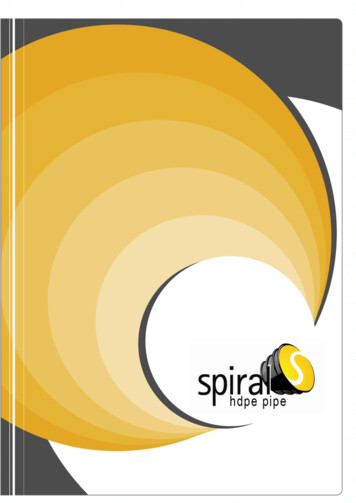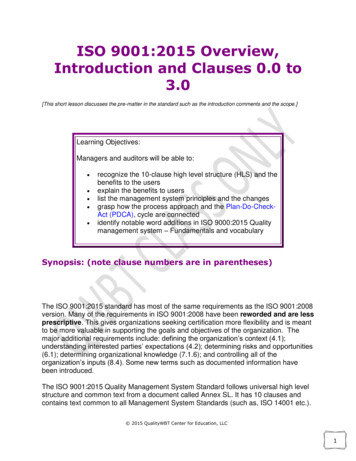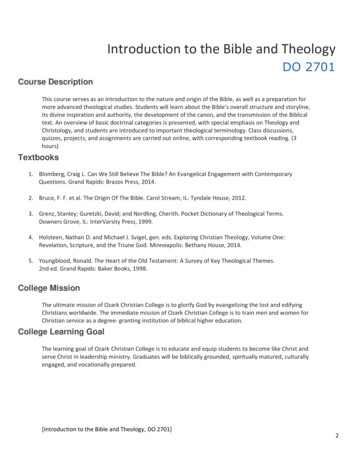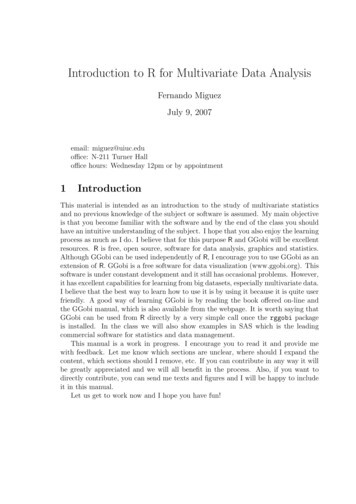
Transcription
Over the years, traditional material used for sewerage and waste disposal pipelines havebeen found to be deficient. Some become brittle and others are subject to attack from theeffluent carried and gasses created in the pipe or from aggressive soil conditions.This led to the use of flexible pipes such as High Density Polyethylene (HDPE), which canwithstand present day traffic loads, deep laying conditions and chemical attack.INTRODUCTIONSPIRAL HDPE PIPE produces a spirally woundstructured wall pipe manufactured from PE-HDknown as SPIRAL Structured Wall HDPE Pipe.It is available in diameters ranging from400mm to 3 500mm.The SPIRAL Structured Wall HDPE Pipe systemis economical and competitive, as thestructured wall concept creates a pipe withsuperior ring stiffness, utilising considerablyless raw material than conventional solidwalled thermoplastic pipes of equal stiffness.SPIRAL Structured Wall HDPE Pipefeatures include:·Resistance to chemical attack,abrasion, scale, sediment build-up andUV degradation.·No electrolytic or galvanic corrosion·Lightweight·Long lengths·High impact strength·Superior flow characteristics·Flexibility·Variety of jointing methods·Comprehensive range of fittings·Cost savings in transportation,handling and installation.MANUFACTUREIn the manufacture of SPIRAL Structured WallHDPE Pipe a specially designed inner liner iswound upon a heated rotating mandrel. Ahollow extruded rectangular profile, is thenwound over the inner liner and intimatelybonded to it. This innovative wall constructionuses geometric efficiency to maximizes ringstiffness.A wide range of profile sizes and windingPitches are available for almost allrequirementsin any type of soil condition.Because SPIRAL Structured Wall HDPE Pipe ismanufactured on a mandrel, the internaldiameter remains constant for each nominalsize, irrespective of wall profile or thickness.The versatile nature of HDPE permits thecustom fabrication of bends, tees and manhole units to compliment the pipes, as well ascorrosion resistant tanks to meet a wide rangeof applications.Principal applications for SPIRAL StructuredWall HDPE Pipe include:·Gravity trunk sewer mains·Sewer rising mains·Storm water drainage·Sub soil drainage·Corrosion resistant tanks.Spirally wound structured wall pipemanufactured from PE-HD.page 2
MATERIAL PROPERTIESTemperature effectsSPIRAL Structured Wall HDPE Pipe offers anoptimum combination of strength anddurability.Generally with buried pipe applications,variable temperatures are not a designconcern because of the restraining action ofthe surrounding soil and the inherent stressabsorbing capabilities of HDPE. The workingtemperature of HDPE extends up to 60ºC. Aswith all thermoplastics, an increase intemperature tends to reduce stiffness andimprove ductility. With a decrease intemperature, the opposite effect occurs. Whenworking outside the ambient temperaturerange, these effects should be taken intoconsideration by the designer.Chemical and corrosion resistanceHigh density polyethylene (HDPE) is an idealpipe material due to its outstanding resistanceto corrosive and aggressive chemicalenvironments. The material is used extensivelyfor sewer applications as it is inert to hydrogensulphide gas. SPIRAL Structured Wall HDPEPipe is not affected by scale and sedimentbuild-up experienced in pipes made oftraditional materials and is not subject toelectrolytic or galvanic corrosion.Abrasion resistanceHDPE is highly resistant to abrasion (two tothree times that of steel) and is vastly superiorto other commonly used pipe materials asshown in Fig 1. HDPE pipelines are usedextensively in industrial and miningapplications for the discharging of effluentscontaining chemicals and sediments.*Reference; Tiede, W ; Abriebuntersuchung aneiner halbschale aus Hostalen GM 5010.Bericht No. 205/77 Techn. Hoch-schuleDarmstadt 1977.Weather resistanceThe most common stabilizing material used inpipe grade HDPE is carbon black, which actsas a barrier to ultraviolet rays.This enables SPIRAL Structure Wall Pipe to beused for above ground applications or to bestored for extended periods in direct exposureto sunlight without damaging the properties ofHDPE material.DIMENSIONSA variety of sizes is available, ranging from400mm – 3.500mmFig 1: Average abrasion values for pipesmade from various materials.page 3
SPIRAL Structured Wall HDPE Pipe is availablein the following sizes and ring stiffness 140018002000250030003500Ring stiffnesskN/m²ISO 9969 / SANS 248248Depending on the quantity required, specialsizes and ring stiffness can be manufactured.FEATURESLightweightSPIRAL Structured Wall HDPE Pipe isconsiderably lighter than other pipe materialsas shown in Fig. 2The savings which result from the use oflightweight pipe can be significant. Transportcosts are reduced, installation equipment maybe smaller and less expensive to operate andjob site handling efficiency improved, usuallyresulting in earlier completion.Easy installations with the integral socket andspigot.DurabilityThe impact resistance of HDPE is quiteoutstanding. The tough ductile nature of thepipe enables it to withstand stresses fromtransportation and site handling that wouldnormally cause breakages with brittle pipematerials. The pipe can inherent flexibility andaccommodate considerable soil movement.LengthStandard pipe length is 6m, and multiples of6m. Non-standard lengths are available onrequest. The advantages of longer lengthstandard pipes are well recognized.Installations are normally faster than forconventional pipe materials. Fewer joints andlonger lengths result in an increase in theamount of pipe laid per day.SPIRAL Structured Wall HDPE effluent pipesare nominally designed for an internal pressureof 1 bar, for a 50 year working lifetime at20ºC. However pipes can be produced forworking pressures of up to 20 bar. Solid wallSPIRAL Pipe, produced by the spiral windingtechnique, is designed to comply with theperformance requirements of SABS ISO4427:1996.Fig. 2: Typical weights of 700mm sewer pipespage 4
INNER COLOURBURIED PIPE PERFORMANCETraditionally customers had to be content withthe black inner surface of HDPE pipes,however now SPIRAL Structured Wall HDPE.Pipe can be supplied with an optional extralight reflecting yellow inner surface, assistingwith the laying and inspection of pipe lines.During installation as well as with future CCTVinspections.The major consideration for the performanceof all buried pipe is the pipe materialcharacteristics.These can greatly affect installation practice.Rigid pipe materials such as reinforcedconcrete (RC) and fiber cement (FC) canwithstand very little deformation beforestructural failure occurs from external loading.In addition, materials such as RC are subjectto chemical attack and traditionally their wallthickness has been increased by the use of asacrificial layer, thus decreasing the internaldiameter.Generally flexible pipes have a much highertolerance to wall strain than rigid materialsand consequently can withstand relativelylarge deformation without failure.This characteristic of flexible pipe allows it todeflect under external load without damage,and transfer a significant amount of theoverburden load to the surrounding soil.Consequently the design principles for flexiblepipes are based on the interaction between thepipe and the surrounding soil.Within the category of plastics used for flexiblepipe manufacture, some materials have amuch higher tolerance to strain than others.Thermoplastics such as HDPE have thehighest tolerance and are extremely ductile innature. Consequently, flexible pipesmanufactured from material other than HDPErequire a higher stiffness in order to maintaindeflection and wall strain within allowabledesign limits for the same ground and loadingconditions.Installation of SPIRAL Structured Wall HDPEPipe usually does not require special liftingequipment.JointingSPIRAL Structured Wall HDPE Pipe offers anumber of jointing methods: The socket andspigot extrusion weld joint is recommended forsewerage, low pressure water supply ordrainage situations where joints may besubject to longitudinal tensile forces. This is afield joint which is accomplished by usingportable HDPE extrusion welding equipment inconjunction with ultra-high frequencyspark testing to ensure leak tight joints. Forpipe sizes up to 500mm in diameter, the jointsare welded on the outside only. For pipe sizes600mm and above, joint welding is usually onthe inside of the pipe, but can be on theoutside or both. In some applications,particularly storm water drainage, welding ofthese joints is often not necessary, and arubber Ogee type sheath, obtainable fromSpiral HDPE Pipe is used.Bends, fittings and manholes aremanufactured to customer specifications.Butt-welded joint is used for high pressureapplications. Hot plate butt welding equipmentis required and can be used either in the fieldor factory.page 5
DESIGNWall strainHDPE is a unique material. It is highlyviscoelastic and, as such, its behavior underload differs from conventional materials.Polyethylene cannot be equated directly to themore rigid and semi-rigid materials such asreinforced concrete, clay, steel and fiberglass.SPIRAL Structured Wall Pipe selected for aparticular project need only have sufficientstiffness to withstand the construction forcesresulting from backfill compaction, initial soilloads and any external hydrostatic pressurefrom ground water.Beyond this, performance of the buried pipesdetermined by the interaction between thepipe and its environment. The critical factorsare the soil modulus at the interfaces betweenpipe and bedding and the in-situ soilThe main pipe design parameters aredeflection, resistance to buckling and wallstrain.The pipe design must take into account theinteraction between these parameters in theinstalled environment. This includes the in-situsoil, the introduced pipeembedment material, the quality of itsplacement and the presence of groundwater.All buried pipes, regardless of the materialused in manufacture, are subject to localisedstrain. This is a function of thestresses caused by external loading. A majorconsideration in design is to ensure that theresultant wall strains do not exceed theallowable strain of the pipe material.Pipes made of materials having a high elasticmodulus (E), i.e. more rigid materials, requirehigh stiffness in load-carrying situations. Thisis because they cannot deflect sufficiently totransfer load to the surrounding soil withoutexceeding their allowable wall strain capacity,often resulting in failure. Conversely, materialssuch as HDPE, with low E values and hightolerance to wall strain can accommodate largelocalized deflections without failure. Even if theallowable wall strain is exceeded in the highlyductile materials, plastic hinging will occur witha redistribution of stresses in the adjacent soil.Consequently, SPIRAL Structured Wall HDPEPipe has considerable reserve capacity for wallstrain, unexpected service conditions such asunstable ground or poor quality installation. Asan example of the pipe’s strain capability,SPIRAL Structured Wall HDPE Pipe is requiredto withstand a flattening test of 60% deflectionwithout structural failure. Fig. 3 represents acomparison of allowable strain values of thecommonly used pipe materials and graphicallydemonstrates the importance of wall strain inpipe selection. This is why pipes made fromless ductile material have a higher stiffnessrequirement under the same loadingconditions.DeflectionControlled deflection is essential with flexiblepipe to maximise the interaction between pipeand soil. Deflection is defined as the ratio ofthe deformed diameter to the un-deformeddiameter and is expressed as a percentage(%). It has become normal practice in Europeto limit the long-term diametrical deflection forpipes manufactured from HDPE to amaximum of 6% at 50 years to maintain thefull pipe design hydraulic performance andjoint integrity.BucklingFor installations where the water table isabove the pipe level, consideration mustbe given to additional load created by theexternal hydrostatic pressure, actingaround the pipe. Appropriate beddingmaterial and installation techniques;however increase the ability of the pipes toresist buckling. A check on the pipe’sresistance to buckling is always carried outat design stage where ground water ispresent. Consideration is given as towhether the pipe is installed in aconstrained or unconstrained environmente.g. backfilled trench or on the sea bed.page 6Ring stiffnessSPIRAL Structured Wall HDPE Pipe can bemanufactured with variable ring stiffnessdepending on inner liner thickness, profile size,and profile winding pitch. Popular classes ofring stiffness are:···.2kN/m²4kN/m²8kN/m²12kN/m² (on request)Pipes with higher ring stiffness can bemanufactured on request.Ring stiffness is determined in accordance withISO 9969 / SANS 21138 Thermoplastics pipes– determination of ring stiffness.
RECOMMENDED INSTALLATIONPRACTICESPIRAL Structured Wall HDPE Pipe is a flexibleconduit, and is designed to deflect underexternal loading to transfer the load from thepipe wall to the surrounding soil.Requirements for achieving satisfactoryinstallation of SPIRAL Structured Wall HDPEPipe do not differ greatly from those of rigidpipe materials. Performance of flexible pipe –soil systems has been demonstrated bylaboratory tests and confirmed in Europe,North America, South America, Australia andSouth Africa.Fig. 1 Watkins graphPipe deformation calculationThe crown deformation underearth load is determined by the Rsvalue on the X – axis of theWatkins graph. (See Fig 1)Rs EB / ER x I/Dm3where :EB soil modulusDm mean pipe diameterER Elastic modulus of materialOn the Y – axis of the Watkinsgraph the relative pipedeformation σv/ξB for a given Rsvalue can be read off.Soil compression value EB can bederived from the calculated value qvand soil modulus EB:InstallationξB qv / EBwhere:qv ρ . Hρ backfill densityH Cover depthFinally, pipe deformation σv is obtained asfollows:σv (σv / ξB ) . ξBand should be designed not to exceed 6% in50 years.Soil Modulus EB is sensitively dependent onembedment material and degree ofcompaction PPr (%) as indicated in Table 1.The most critical aspect for the successfulinstallation of flexible pipe–soil system isachieving stable and permanent side supportaround the pipe. The bedding and initialbackfill materials should be of a readilycompactable nature.Trench excavationThe trench is excavated to the line and gradeas specified. The trench width must besufficient to allow placing and compaction ofthe pipe bedding material with suitableequipment.page 7
BeddingBedding performs the important function ofleveling the trench bottom, assuring uniformsupport and load distribution along the barrelas well as supporting the hunching material.·Care should be takento avoid flotation of the pipe duringpouring of concrete.In situations where cover of pipe isbetween 300mm and 1000mm,crusher run material should be placedand compacted to the normal degreeof 95% Standard Proctor. Thismaterial can be used either to bed andtotally encase the pipe or it can beplaced from the initial backfill – whichshould be soil type 1 or 2 and alsocompacted to 95% to the trafficsurface level.Pipe in trenchPipe jointingFollowing preparation of trench and bedding,pipes are lowered into the trench with suitable lifting equipment. Generally the excavatoror backactor bucket is utilized with a singlesling at the pipe’s midpoint. Pipes of alldiameters can be joined using two chain blocks– The ribbed wall aids with grip for chains.Pipes can also be push–jointed using thebackactor or excavator, the bucket bearing ona piece of timber laid across the pipe face toavoid damage to the jointing surface. Theusual practice is to lay pipes with socketsfacing upstream.Pipe Socket EndTraffic loading situationsIn cases where the installed pipeline will besubjected to repetitive wheel loading with lessthan 1,0m of soil cover, the following practicesare recommended:Pipe should be encased in reinforcedconcrete where cover over the pipe isless than 300mm.page 8Pipe Spigot End
Transport is free, depending on quantities andsite location.We also manufacture specialised tanks of up to3500mm in ID, according to the customer’srequirements.2.5m Diameter Chemical Tank3.5m Diameter HF –Tankpage 9
Specials and site installations.Floats for pumps and mining purposes.AcknowledgementSpiral HDPE Pipe (Pty) Ltd. acknowledges theresearch and development undertaken bymanufacturers of structured wall pipesworld-wide.Contacts:Phone: 27(0)12 377 1670Fax: 27(0)12 379 o.zaadmin@spiral-pipe.co.zaJohann Van ZylCell: 27(0)82 456 7507DisclaimerThe information in this brochure should not beconstrued as a guarantee of specific propertiesof the products or their suitability for aparticular application. Existing property rightsmust be observed. Spiral Structured WallHDPE Pipe guarantees its quality under itsgeneral conditions of sale.Spiral HDPE Pipe (PTY) LtdReg. No.2002/025978/07Unit E3 & E4Kuper Legh Industrial Park1 Moot StreetHermanstadPretoriaGautengBusiness Hours:Monday – Friday 8h00 – 17h00Riaan SteynCell: 27(0)84 400 2307Please visit our pipepage 10
SPIRAL HDPE PIPE produces a spirally wound structured wall pipe manufactured from PE-HD known as SPIRAL Structured Wall HDPE Pipe. It is available in diameters ranging from 400mm to 3 500mm. The SPIRAL Structured Wall HDPE Pipe system is economical and competitive, as the structured wall concept creates a pipe with superior ring stiffness, utilising considerably less raw material than .










